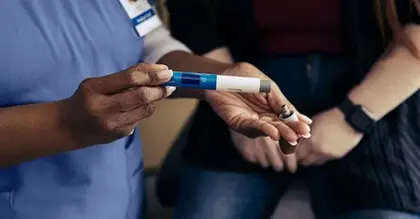Note: This document contains side effect information about hydroxychloroquine. Some dosage forms listed on this page may not apply to the brand name Plaquenil.
Applies to hydroxychloroquine: oral tablets.
Side effects include:
The most common adverse reactions are nausea, vomiting, diarrhea, abdominal pain.
For Healthcare Professionals
Applies to hydroxychloroquine: compounding powder, oral tablet.
Cardiovascular
QT interval prolongation has been reported in patients with specific risk factors, which may lead to arrhythmia (torsade de pointes, ventricular tachycardia).[Ref]
Rare (0.01% to 0.1%): Cardiomyopathy (sometimes resulting in cardiac failure; some with fatal outcome), conduction disorders (bundle branch block/atrioventricular heart block), biventricular hypertrophy
Frequency not reported: Arrhythmia (torsade de pointes, ventricular tachycardia)
Postmarketing reports: QT interval prolongation, ventricular arrhythmias, torsade de pointes[Ref]
Ocular
Common (1% to 10%): Blurred vision (including due to disturbance of accommodation)
Uncommon (0.1% to 1%): Retinopathy (with changes in pigmentation, visual field defects), retinal changes (including paracentral, pericentral ring types, temporal scotomas, abnormal color vision), corneal changes (including edema, opacities), haloes, photophobia
Very rare (less than 0.01%): Extraocular muscle palsies
Frequency not reported: Maculopathies, macular degeneration, abnormal macular pigmentation and depigmentation (sometimes with bull's eye appearance), pallor of optic disc, optic atrophy, narrowing of retinal arterioles
Postmarketing reports: Irreversible retinopathy with retinal pigmentation changes (bull's eye appearance), visual field defects (paracentral scotomas), visual disturbances (visual acuity), maculopathies (macular degeneration), decreased dark adaptation, color vision abnormalities, corneal changes (edema, opacities), corneal deposition of drug with or without accompanying symptoms (halo around lights, photophobia, blurred vision[Ref]
Blurred vision (temporary) and extraocular muscle palsies (reversible) were due to disturbance of accommodation, which was dose dependent and reversible.
Retinopathy appeared to be uncommon when the recommended daily dose was not exceeded. In its early form, it appeared reversible when therapy was discontinued. If allowed to develop, there was risk of progression even after treatment withdrawal.
Patients with retinal changes were asymptomatic initially or had scotomatous vision with paracentral, pericentral ring types, temporal scotomas, and abnormal color vision.
Corneal changes (including edema and opacities) have occurred from 3 weeks (infrequently) to some years after starting therapy. They were either symptomless or caused disturbances such as haloes, blurred vision, or photophobia; they may be transient and were reversible when therapy was discontinued.
Maculopathies and macular degeneration have been reported (onset ranging from 3 months to several years of exposure to this drug) and may be irreversible.[Ref]
Gastrointestinal
Very common (10% or more): Abdominal pain, nausea
Common (1% to 10%): Diarrhea, vomiting[Ref]
In general, abdominal pain, nausea, diarrhea, and vomiting resolved immediately when the dose was reduced or therapy was stopped.[Ref]
Dermatologic
In general, skin rash, pruritus, pigmentation disorders in skin and mucous membranes, bleaching of hair, and alopecia resolved readily when therapy was discontinued.
AGEP had to be distinguished from psoriasis, although this drug has precipitated attacks of psoriasis. AGEP has been associated with fever and hyperleukocytosis. In general, outcome was favorable after stopping this drug.[Ref]
Common (1% to 10%): Skin rash, pruritus, alopecia
Uncommon (0.1% to 1%): Pigmentary changes, pigmentation disorders in skin and mucous membranes, bleaching of hair
Rare (0.01% to 0.1%): Attacks of psoriasis
Very rare (less than 0.01%): Dermatitis bullous eruptions, erythema multiforme, Stevens-Johnson syndrome, toxic epidermal necrolysis, drug rash with eosinophilia and systemic symptoms (DRESS) syndrome, photosensitivity, exfoliative dermatitis, acute generalized exanthematous pustulosis (AGEP)
Frequency not reported: Urticaria, angioedema
Postmarketing reports: Hair color changes[Ref]
Metabolic
Common (1% to 10%): Anorexia
Rare (0.01% to 0.1%): Exacerbation/precipitation of porphyria
Postmarketing reports: Hypoglycemia, decreased appetite, porphyria[Ref]
Nervous system
Common (1% to 10%): Headache
Uncommon (0.1% to 1%): Dizziness, nerve deafness, vertigo, tinnitus
Rare (0.01% to 0.1%): Seizure/convulsions, neuromyopathy
Very rare (less than 0.01%): Nystagmus, ataxia
Frequency not reported: Hearing loss
Postmarketing reports: Extrapyramidal disorders (e.g., dystonia, dyskinesia, tremor), deafness[Ref]
Psychiatric
Common (1% to 10%): Affect/emotional lability
Uncommon (0.1% to 1%): Nervousness
Very rare (less than 0.01%): Psychosis, suicidal behavior, nightmares
Postmarketing reports: Irritability[Ref]
Hepatic
Uncommon (0.1% to 1%): Abnormal liver function tests
Very rare (less than 0.01%): Fulminant hepatitis
Postmarketing reports: Acute/fulminant hepatic failure[Ref]
Musculoskeletal
Uncommon (0.1% to 1%): Sensorimotor disorders
Frequency not reported: Absent/hypoactive deep tendon reflexes
Postmarketing reports: Skeletal muscle myopathy/muscle weakness/neuromyopathy (leading to progressive weakness, atrophy of proximal muscle groups), depression of tendon reflexes, abnormal nerve conduction studies[Ref]
Myopathy has been reversible after therapy discontinuation, but recovery has taken many months.[Ref]
Hematologic
Rare (0.01% to 0.1%): Bone-marrow failure/depression, anemia, aplastic anemia, leukopenia, thrombocytopenia
Very rare (less than 0.01%): Agranulocytosis
Postmarketing reports: Hemolysis (in glucose-6-phosphate dehydrogenase deficient patients)[Ref]
Other
Very rare (less than 0.01%): Weight decreased/loss, fatigue/lassitude[Ref]
Respiratory
Postmarketing reports: Bronchospasm[Ref]
Hypersensitivity
Frequency not reported: Allergic reactions (urticaria, angioedema, bronchospasm), hypersensitivity myocarditis[Ref]




